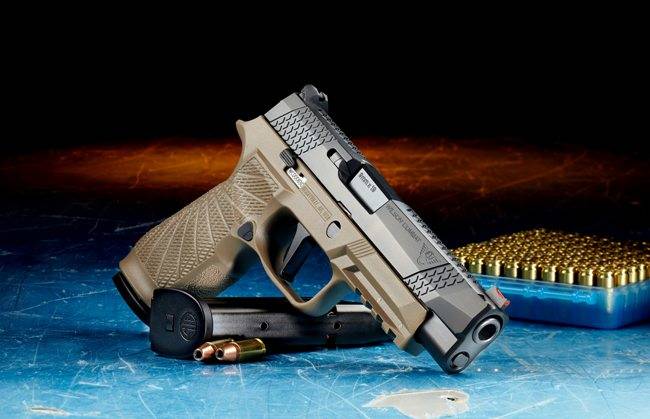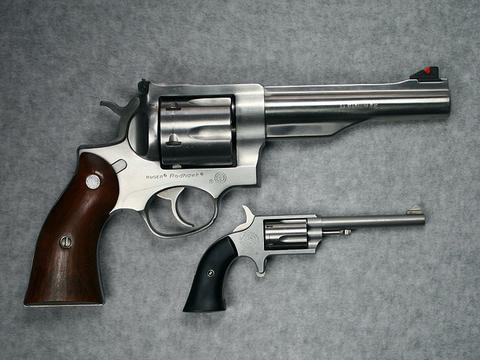Regarding the handguns available for sale, there are countless models from different brands to choose from. You do not have to worry about that because there are some tips for you to pick up a suitable handgun. This article will show you how to select your first handgun.
To make it easier for you guys to keep up with, we have broken down this writing into smaller parts, which respectively discuss the factors of choosing a good handgun. Let’s fire it up.

Contents
How To Select Your First Handgun
Before going into detail, we need to have a quick look at which factors make up a perfect handgun for beginners. They are your intended use, budget, preferred size, the action, the calibers, and the frame material of the handgun. Now, let’s find out the steps in choosing the best handgun for you.
Intended Use
The first step is locating whether you need a handgun or other stronger firearm, such as a rifle or shotgun.
Most of the time, first-time users seek a gun just for self-defense purposes around their residual area. In this case, it would be best for these entry-level users to buy a basic shotgun or sporting rifle.
These guns can provide thorough protection and ask for little training to be proficient at casual home defense. However, these long firearms are more challenging to hide, keep, and secure in the home than handguns.
Handguns, on the other hand, are famous for their portability, concealed carry, and convenience. Most of the time, entry-level shooters who want to cause critical damage to attackers would go for handguns first in their mind. The price range of handguns is wide, too, allowing different users to pick the suitable gun.
Speaking of recoil response, the handguns are normally going with diminished recoil force, which would benefit new users in the early phase of training.

Budget
The second thing to consider is your budget to spend on firearms.
After deciding on purchasing a handgun, you probably face the dilemma of pricing. Admittedly, this is one of the most complicated things to think about. Yet, remember the saying, “ You get what you pay for”.
There are several types of handguns in the market to match all income levels, ranging from inexpensive handguns for $200 to customized competition guns of hundreds or thousands of dollars.
And most importantly, you are the only one who can know your budget. The recommended prices for entry-level handguns are from around the $350 to $850 range. As this price range is wide, the set of handguns falling in these rates vary in reliability, style, ergonomic, design, and warranty coverage.
Size
Apart from price, we should also look at the size of the handguns to see if they suit you best. These sizes are full-size, compact, sub-compact, and pocket guns.
Firstly, let’s talk about full-size handguns or duty-sized. This kind of handgun is the easiest to shoot since its size allows it to absorb recoil forces. Full-size guns also possess a long sight radius, which adds more accuracy to distance shooting. In terms of magazine capacity, the duty-sized gun often has an extended grip to increase the magazine capacity. Finally, this gun has a longer barrel, resulting in more powerful functioning.

Next, compact handguns often go with a bit shorter slide and grip compared to their full-size models. They have a tendency to maintain controllability but are limited on the shooting carry. However, this kind of handgun is among the most popular handguns serving the civilian market owing to its capability to perform various roles.
Now, let’s move to the sub-compact handguns. This size is even smaller than compact ones. With this size, the slide and grip length is cut down more, forcing users to use a two-finger grip. Even though this feature makes them harder to master for entry-level shooters, their size proves to have good concealed carry.
Finally, pocket handguns are on the top of the smallest and easiest firearm to conceal, but coming with that is also the hardest size to shoot. To master it, shooters are required to spend more time in training to be proficient with this kind of handgun, not to mention the limited shooting range. It is easier for you to carry one every day.
Action

Single-action pistols require that a hammer be moved upward manually per time to take a shot. In a more simple term, single-action means one single trigger pull sets fire to one shot.
The advantage of a single-action handgun is that the act of pulling the trigger pull is light and short. In detail, shooters do not need to spend much hand strength, which can influence the accuracy. That explains, many people, especially new users, favor single-action triggers to gain a smoother shooting experience. However, the shortcoming of single-action is that you have to cock the hammer to proceed with every single shot.
Speaking of double-action firearms, these guns possess a trigger press that pulls the striker or the hammer back and unleashes it each time we pull the trigger. As a result, it is heavier to pull the trigger, leading to a safer way to prevent a possible accident. This model is harder for new shooters to use; however, it provides accurate shots.
Calibers
Now, let’s discuss the calibers. The most popular and affordable choice goes for the 9mm Luger. Specifically, this decent caliber offers you a pretty good capacity and powerful shots for defense. The recoil factor is minimized, and placing multiple accurate shots is maximized.
In case you do not worry about the recoil and you are looking for something more powerful, you can take a look at .45 ACP, .40 S&W, and .357 Magnum firearms.
Frame Material

It is time to talk about the frame material you can choose from, including Polymer frames, alloy frames, and steel frames.
Speaking of Polymer frames, they are the least heavyweight and can diminish the recoil shock felt by the hand after shooting. When it comes to moist immunity, Polymers do not erode with humidity, making it a great gun to carry in the summer months with high rain precipitation.
Alloy frames, on the other hand, offer you the lightweight feeling of the polymer as well as the classical feel of a metal firearm. Alloy frames tend to resist corrosion compared to carbon steel at a certain level.
Lastly, steel frame models go with the old-school feel and are easier to shoot due to their heavyweight. And for durability, the steel frames overtakes the two other materials.
Conclusion
Hopefully, after reading this article on how to select your first handgun, you have taken away some key information. Just remember that there are several factors contributing to picking up the right suitable handgun.
It would be right to state that there is not a one-for-all handgun that fits everybody. The choice needs to come from personal preferences.

I am Jerry Gonzalez, and my heart beats for the great outdoors, especially in the breathtaking landscapes of Helena, Montana. Engaging with fellow enthusiasts online and at local hunting clubs has been a rewarding experience, and I find great joy in sharing knowledge and experiences with like-minded individuals. My goal is to empower my fellow hunters with well-informed choices, regardless of their experience level.
